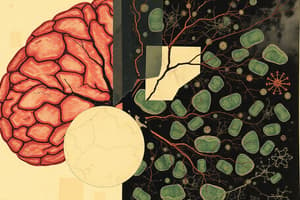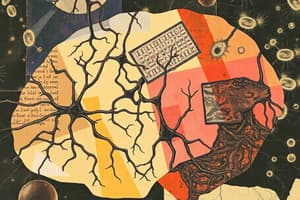Podcast
Questions and Answers
What are the main components of a neuron and their functions?
What are the main components of a neuron and their functions?
The main components of a neuron are the cell body (soma), dendrites, and axon. The cell body contains the nucleus, dendrites receive signals, and the axon transmits impulses away from the cell body.
What role do glial cells play in the function of nervous tissue?
What role do glial cells play in the function of nervous tissue?
Glial cells support and protect neurons, maintain homeostasis, form myelin, and act as immune cells in the nervous system. Their functions are essential for the overall health and efficiency of the nervous tissue.
Describe the significance of myelin sheaths in the nervous system.
Describe the significance of myelin sheaths in the nervous system.
Myelin sheaths insulate axons and increase the speed of electrical signal transmission. They allow for rapid communication between neurons through saltatory conduction at the Nodes of Ranvier.
What is neurotransmission and why is it important for neural communication?
What is neurotransmission and why is it important for neural communication?
What are Nodes of Ranvier and their role in signal propagation?
What are Nodes of Ranvier and their role in signal propagation?
How do astrocytes contribute to the health of neurons?
How do astrocytes contribute to the health of neurons?
What are the implications of neurodegenerative diseases on nervous tissue?
What are the implications of neurodegenerative diseases on nervous tissue?
What are the roles of dopamine and serotonin in the nervous system?
What are the roles of dopamine and serotonin in the nervous system?
Flashcards are hidden until you start studying
Study Notes
Nervous Tissue
-
Definition: Nervous tissue makes up the brain, spinal cord, and nerves. It is responsible for transmitting signals and processing information throughout the body.
-
Main Cell Types:
- Neurons:
- Specialized cells that transmit nerve impulses.
- Consist of three parts:
- Cell Body (Soma): Contains the nucleus and organelles.
- Dendrites: Receive signals from other neurons.
- Axon: Transmits impulses away from the cell body to other neurons or muscles.
- Glial Cells (Neuroglia):
- Support cells that protect and assist neurons.
- Types include:
- Astrocytes: Provide structural support and regulate blood flow.
- Oligodendrocytes: Form myelin sheaths around axons in the CNS.
- Schwann Cells: Form myelin sheaths around axons in the PNS.
- Microglia: Act as immune cells in the nervous system.
- Neurons:
-
Functions:
- Signal Transmission: Neurons communicate through electrical impulses and neurotransmitters.
- Processing Information: Integration of sensory input and motor output occurs in the brain and spinal cord.
- Support and Protection: Glial cells maintain homeostasis, form myelin, and protect neurons from injury.
-
Myelin Sheath:
- Fatty layer that insulates axons.
- Increases the speed of electrical signal transmission.
- Gaps in the sheath are called Nodes of Ranvier, contributing to saltatory conduction.
-
Neurotransmission:
- Process by which neurons communicate across synapses using neurotransmitters.
- Important neurotransmitters include:
- Dopamine: Involved in reward and motivation.
- Serotonin: Regulates mood and sleep.
- Acetylcholine: Plays a role in muscle activation and memory.
-
Pathology:
- Neurodegenerative Diseases: Conditions like Alzheimer's and Parkinson's result from the degeneration of nervous tissue.
- Trauma: Injury to nervous tissue can lead to loss of function and disability.
-
Regeneration:
- Limited in the central nervous system (CNS); some regeneration can occur in the peripheral nervous system (PNS) under certain conditions.
-
Research Areas:
- Neural stem cells and their potential for repair.
- Impact of neuroinflammation on neurodegenerative diseases.
Nervous Tissue Overview
- Comprises the brain, spinal cord, and nerves; essential for signal transmission and information processing.
Main Cell Types
- Neurons:
- Specialized for transmitting nerve impulses, essential for communication within the nervous system.
- Structure consists of:
- Cell Body (Soma): Houses the nucleus and organelles.
- Dendrites: Short extensions that receive signals from other neurons.
- Axon: Long process that carries impulses away from the soma to other neurons or muscles.
- Glial Cells (Neuroglia):
- Non-neuronal support cells that protect and assist neurons.
- Varieties include:
- Astrocytes: Provide structural support, regulate blood flow in the brain.
- Oligodendrocytes: Create myelin sheaths around axons in the central nervous system (CNS).
- Schwann Cells: Form myelin sheaths around axons in the peripheral nervous system (PNS).
- Microglia: Function as immune defense cells in the nervous system.
Functional Roles
- Signal Transmission: Utilizes electrical impulses and neurotransmitters for neuron communication.
- Information Processing: The brain and spinal cord integrate sensory information and determine motor responses.
- Support and Protection: Glial cells maintain homeostasis and protect neuronal integrity.
Myelin Sheath
- A fatty layer that insulates axons, enhancing the speed of electrical signal transmission.
- Contains Nodes of Ranvier, gaps that facilitate rapid signal conduction through saltatory conduction.
Neurotransmission
- The process where neurons communicate across synapses using neurotransmitters.
- Significant neurotransmitters include:
- Dopamine: Key role in reward pathways and motivation.
- Serotonin: Regulates mood, sleep, and cognitive functions.
- Acetylcholine: Important for muscle activation and forming memories.
Pathology
- Neurodegenerative Diseases: Conditions like Alzheimer's and Parkinson's lead to the loss of neurons and function.
- Trauma: Damage to nervous tissue can cause functional impairments or disabilities.
Regeneration
- Limited capacity in the CNS; however, some regeneration is possible in the PNS under certain conditions.
Research Areas
- Exploration of neural stem cells for potential tissue repair.
- Investigation into the role of neuroinflammation in neurodegenerative diseases.
Studying That Suits You
Use AI to generate personalized quizzes and flashcards to suit your learning preferences.




